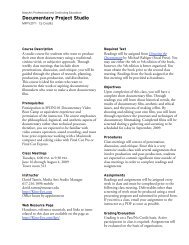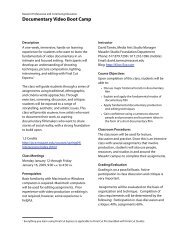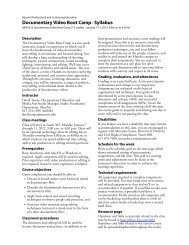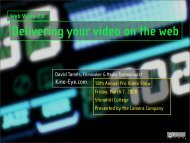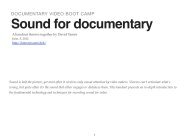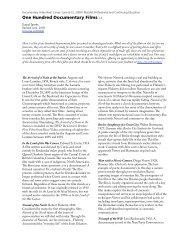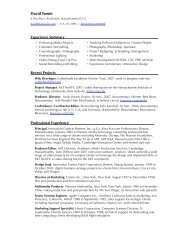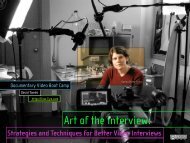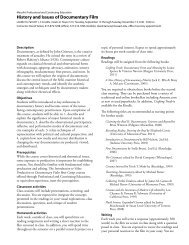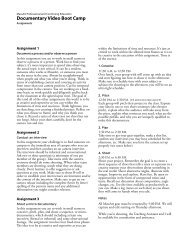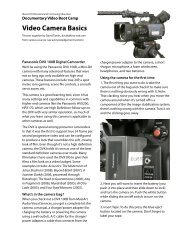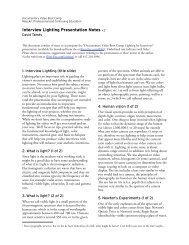Documentary Project Proposal Template - Kino
Documentary Project Proposal Template - Kino
Documentary Project Proposal Template - Kino
You also want an ePaper? Increase the reach of your titles
YUMPU automatically turns print PDFs into web optimized ePapers that Google loves.
<strong>Documentary</strong> <strong>Project</strong> <strong>Proposal</strong> <strong>Template</strong><br />
<strong>Documentary</strong> Video Boot Camp<br />
June 14-18, 2010<br />
Adapted by David Tamés from a document by Peter Thompson based on the book Directing the <strong>Documentary</strong> by<br />
Michael Rabiger.<br />
Working Title:<br />
Producer:<br />
Director:<br />
Cameraperson:<br />
Sound recordist:<br />
Editor:<br />
Other collaborators:<br />
Working Hypothesis and Interpretation<br />
What are your persuasions about the world you are going to show in your film, the main<br />
“statement” that you want to emerge out of the filmʼs dialectics? Write a hypothesis statement<br />
incorporating this wording:<br />
In life I believe that:<br />
My film will show this in action by exploring (situation):<br />
The main conflict is between:<br />
Ultimately, I want the audience to feel:<br />
and to understand that:<br />
Topic<br />
Write a concise paragraph about:<br />
1. Your filmʼs subject (person, group, environment, social issue, etc.)<br />
2. The necessary background information the audience must have to understand and to be<br />
interested in the enclosed world you intend to present. Be sure to show how this<br />
information will emerge.<br />
Action Sequences<br />
Write a brief paragraph for each intended sequence that shows an activity. (A sequence is<br />
usually delineated by being in one location, one chunk of time, or an assembly of materials to<br />
show one topic). Incorporate the following:<br />
1. What the activity is and what conflict it evidences<br />
2. A metaphor to explain its subtextual meaning<br />
3. The expected structure of events<br />
4. What the sequence should contribute to the whole film and to the hypothesis<br />
5. What facts the audience must gather from watching it<br />
6. What key, emblematic imagery you hope to capture<br />
Main Characters<br />
Write a brief paragraph about each of your main characters. For each include:
1. Who (name, relationship to others in film and so on)<br />
2. Where (where does this person fit in the scheme of things?)<br />
3. What (what is this characterʼs role, what makes the character(s) interesting, worthy of<br />
special attention and significant? What is this character trying to do or to get at?)<br />
Conflict<br />
What is at issue in this film? Consider:<br />
1. Who wants what of whom?<br />
2. What conflicting principles do the characters stand for?<br />
3. Does your film put different principles in opposition (of opinion, of view, of vision and so<br />
forth)?<br />
4. How will we see one force finally meet with the other? (the “confrontation”--very<br />
important)<br />
5. What range of possible developments do you see emerging from this confrontation?<br />
Audiences Biases<br />
To make a documentary means not only using conflicting “evidence” to put forward your<br />
subjectʼs dialectics, it also means knowing what stereotypes or expectations carried by your<br />
audience your film must deliberately set out to alter.<br />
1. Biases ( may be positive or negative)<br />
2. What alternative views, facts or ideas does the audience need to understand<br />
3. What evidence will you show to get the audience to see those different truths<br />
On Camera Interviews<br />
For each interview, list:<br />
1. Name, role in life, metaphoric role in filmʼs dramatic structure<br />
2. Main elements the interview will seek to establish<br />
Structure<br />
Write a brief paragraph on how you hope to structure your film. When you are doing this,<br />
consider:<br />
1. How will you will handle the progression of time in the film<br />
2. How and at what point information important to story development will appear<br />
3. What you intend as the climactic sequence and where this should go<br />
4. How this relates to other sequences in terms of the action rising toward the filmʼs<br />
projected “crisis” or emotional apex and the falling action after it<br />
5. Sequences or interviews you intend to use as parallel storytelling<br />
Form and Style<br />
Any special considerations in shooting or editing style that might further your filmʼs content.<br />
Here you might comment on narrative lighting, camera handling, type and amount of<br />
intercutting, juxtaposition of scenes, parallel storytelling and the like.<br />
Resolution<br />
Write a brief paragraph about how you imagine your film will end and what you would like the<br />
ending to accomplish for the audience. Comparing any intended ending with the filmʼs beginning<br />
Document <strong>Project</strong> <strong>Proposal</strong> <strong>Template</strong> http://kino-eye.com/dvb/ 2
also exposes what must accomplish as a story to get there. The ending is your last word to the<br />
audience and has a disproportionate influence on what the film will mean.<br />
Unique Qualifications<br />
Why are you and no one else in the world uniquely qualified to make this film? Do you have<br />
access to the subject that no one else has? Are you making a personal film that only you can<br />
make? Do you have a unique personal experience to share?<br />
Budget<br />
The following is a generic set of categories to get you started. Each production will have itʼs own<br />
unique set of expenses.<br />
Producer, Director, and Staff<br />
• Producer<br />
• Director<br />
• Associate Producer<br />
• Research assistants<br />
• Copies, phone calls, postage<br />
• Misc. producer expenses<br />
Talent<br />
• Voice-over talent<br />
• Stipends for interviewees<br />
Camera<br />
• Cinematographer<br />
• Camera assistant<br />
• Production assistant<br />
• Camera package<br />
• Lighting & grip package<br />
• Expendables and supplies<br />
Travel<br />
• Car rentals<br />
• Gas<br />
• Tolls<br />
• Taxi<br />
• Airfare<br />
• Hotel room<br />
• Per diems<br />
Location Expenses<br />
• Location fees<br />
• Crew meals<br />
• Misc. location expenses<br />
Sound<br />
• Production sound mixer<br />
• Sound package<br />
• Expendables and supplies<br />
Media & Storage<br />
• Tape stock<br />
• Hard drives<br />
• Media cards<br />
• Backup/Archive media<br />
Document <strong>Project</strong> <strong>Proposal</strong> <strong>Template</strong> http://kino-eye.com/dvb/ 3
• Safety deposit box rental<br />
Editorial<br />
• Off-line editor<br />
• Off-line editing system rental (tech support, decks, storage, etc.)<br />
• Dubs and transfers<br />
• Assistant editor<br />
• On-line editor / colorist<br />
• On-line equipment rental<br />
• Misc. equipment<br />
• Expendables and supplies<br />
Music<br />
• Composer<br />
Sound Mix<br />
• Sound editor/mixer<br />
• Sound editing system<br />
• Sound effects library license<br />
• Layback<br />
• Expendables and supplies<br />
Titles and Motion Graphics<br />
• Freelance designer<br />
• Expendables and supplies<br />
Web Site<br />
• Freelance designer<br />
• Hosting fees<br />
• Expendables and supplies<br />
Rights and Clearances<br />
• Motion picture/Television clips<br />
• Stock footage<br />
• Music rights<br />
• Archive masters<br />
• Legal fees<br />
Legal and Administrative fees<br />
• Workmenʼs compensation insurance<br />
• General liability insurance<br />
• Production insurance<br />
• Errors and omissions insurance<br />
• Legal fees<br />
• Copies, phone calls, postage<br />
• Misc. administration fees<br />
Logistics<br />
Briefly address any obvious problems of feasibility, practicality and so on.<br />
Document <strong>Project</strong> <strong>Proposal</strong> <strong>Template</strong> http://kino-eye.com/dvb/ 4



